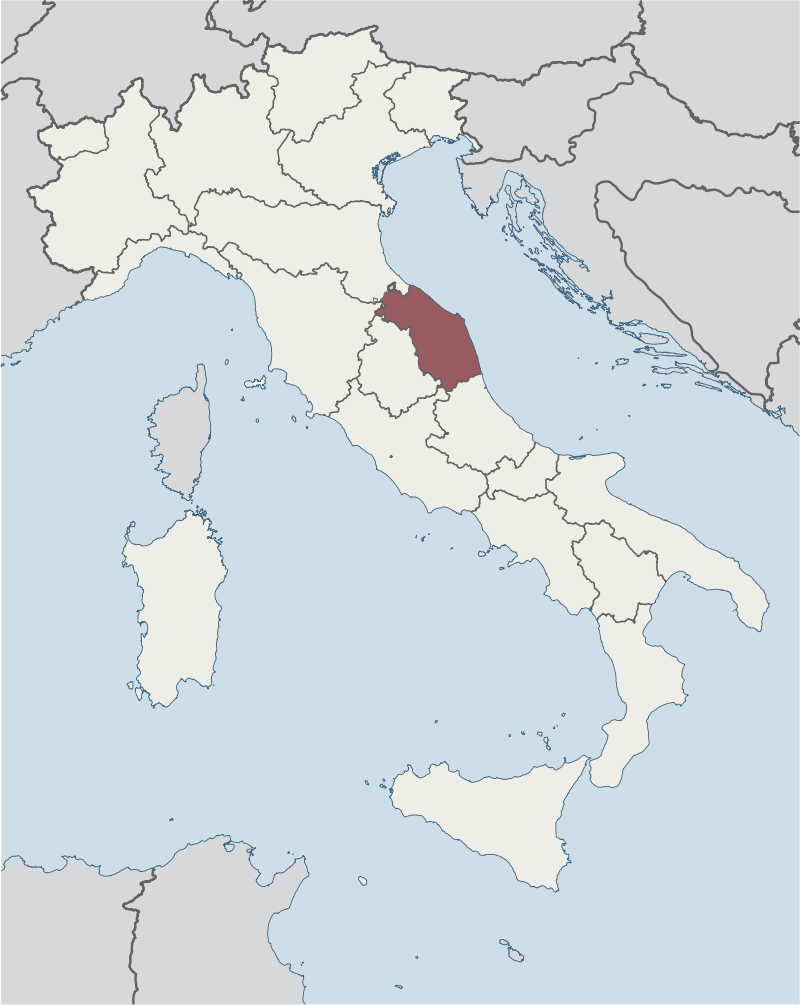Population: 1,525.271 (Eurostat, 2020)
Area: 9,382 km2
The region is divided into five provinces: Ancona (regional capital), Ascoli Piceno, Fermo, and Macerata, as well as Pesaro and Urbino where the demonstrator is centered.
NUTS-3 for Pesaro-Urbino: ITI31
There are 52 municipalities in Pesaro and Urbino covering an area of 2.567,71 km2 with a population of 356.497. The five largest municipalities by population are:

The landscape is a blend of sea and mountains, making Pesaro-Urbino a sought-after destination. The area is a popular destination for tourists seeking a variety of experiences, especially agrotourism and cultural heritage tourism for the rich history of the province in the arts, music and literature. Urbino, birthplace of Raphael (one of the four great Masters of Renaissance Art), and Pesaro, birthplace of Gioachino Rossini (opera composer), contribute to the region’s cultural richness.
Pesaro is situated by the Adriatic Sea, offering a mild climate ideal for tourism. While the Adriatic coast has been a long-standing tourist destination, the inland rural areas maintain an authentic Italian culture.
The province consists of 52 municipalities, with 44 having fewer than 5,000 inhabitants and 37 having less than 3,000. Approximately 43% of the population (155,796 residents) resides in Pesaro and Fano, while about one third of the population resides in medium-sized municipalities (population between 5,000 and 50,000 inhabitants) like Urbino, Mondolfo or Vallefoglia.
Recovery policies for agriculture and agritourism aim to counter the massive agricultural exodus of the sixties. As of 2013, there were 41,745 registered companies, with 36,777 active (88.1%). These span various sectors, including commerce, construction, manufacturing, agriculture/fishing, and accommodation/catering.
Despite a relative improvement in unemployment rates from 1991-2001 (6.1% to 5.3%), the last census recorded a significant increase, reaching 8.5%.
The Gruppo Azione Locale (G.A.L. Montefeltro Sviluppo Local Action Group), headquartered in Urbania, plays a pivotal role in promoting sustainable development of the area. Operating beyond program implementation, the group acts as a catalyst for socio-economic development, fostering collaboration between local authorities and economic/social operators. Their efforts are directed toward rural development, vocational training, tourism promotion, and support for local system development across various sectors.
In essence, Pesaro-Urbino stands as a vibrant province, blending economic diversity, cultural heritage, and natural beauty. The Local Action Group is a key player in steering sustainable development and collaborative growth in the region until at least December 2030.

Situated in the Marche Region, the Province of Pesaro and Urbino is a historically rich and naturally stunning territory. Stretching from the Apennines to the Adriatic Coast, it boasts treasures like the Park of Sasso Simone and Simoncello, Mounts Catria and Nerone, and the Furlo canyon. Urbino, a Renaissance Capital and UNESCO heritage site, adds cultural and historical richness.
Craft traditions, notably ceramics, meet with some of the most valued flavours of Italian Cuisine, such as the white truffle. As an early adopter of organic farming since the 1970s, Pesaro-Urbino stands as a pioneer of good practices in agriculture.

Museum Graphia has dedicated over two decades to preserving the cultural and material heritage of printing, spanning from its origins to the present day. Collaborating with La Corte della Miniera, it offers educational trips and activities for schools.
The Artistic Center hosts diverse workshops for schools or groups, providing immersive experiences in a farmhouse setting. Additional artisanal techniques can be explored upon request, including tailored programs for educational projects.
Located near Urbino, the Museum combines cultural immersion in the Renaissance legacy with the natural beauty of Marche's hinterland, characterized by lush green hills and easy access to the sea. As part of the Ruralities project, it actively participates in disseminating project outcomes and organizing educational activities for local schools (living labs).

The ancient sulfur mine of Urbino, operational for over a century and a significant employer, has been transformed into La Corte della Miniera, an Artistic Center. The mine's basement melting furnaces now house art laboratories, screening rooms, and libraries, while external structures serve as reception, catering, and sports centers. La Corte della Miniera, existing for over 33 years, specializes in group tourism, offering warm hospitality, creative experiences, and attention to detail. With high-quality, all-inclusive services, including catering, safety plans, and staff training, the center ensures a seamless experience for visitors, earning acclaim from schools and professional organizations. It uniquely combines the historical significance of the sulfur mine with the creative energy of an Artistic Center.

Located within the San Bartolo Natural Park, the Institute operates on a 25-hectare agricultural estate at historic Villa Caprile. It features cultivated areas, vineyards, olive groves, orchards, and greenhouses, providing practical learning for agricultural operations. The complex includes administrative offices, classrooms, laboratories, and boarding facilities, serving over 1200 students with diverse educational experiences. Offering boarding options, the Institute houses laboratories for various subjects and collaborates with local businesses and authorities to provide courses, projects, and professional opportunities. With a history dating back to 1827, the Institute remains committed to agricultural education and innovation, celebrating its 140th year in 2016 and continuously evolving to meet changing educational and workforce needs.

This project has received funding from the European Union’s Horizon Europe research and innovation program under grant agreement no 101060876. UK participants in Horizon Europe Project RURALITIES are supported by UKRI grant numbers: 10051963 The Highlands and Islands Transport Partnership and 10050988 Earthwatch Europe.
